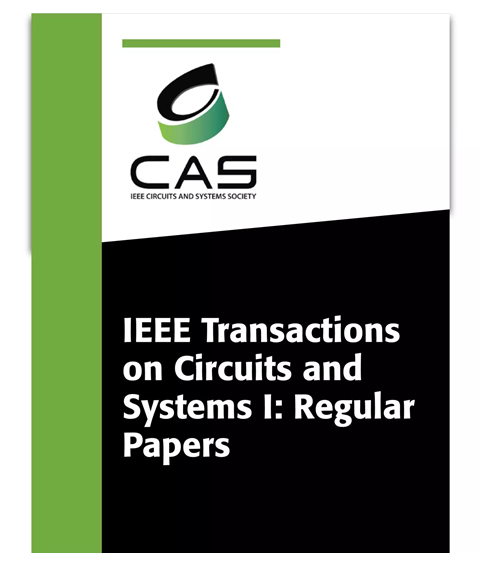利用片上可配置电流转向测温 DAC 改进线性度的过程变化感知内存计算
IF 5.2
1区 工程技术
Q1 ENGINEERING, ELECTRICAL & ELECTRONIC
IEEE Transactions on Circuits and Systems I: Regular Papers
Pub Date : 2024-08-02
DOI:10.1109/TCSI.2024.3422883
引用次数: 0
摘要
内存计算(IMC)是一种提高数据密集型设计速度和能效的潜在技术。然而,由于模拟乘积 (MAC) 运算的非线性和工艺变化影响了高位宽 MAC 运算的精度,IMC 对大型系统的可扩展性受到了阻碍。在本文中,我们介绍了一种 IMC 架构,该架构能够执行多比特 MAC 运算,并提高了速度、线性度和计算精度。为了提高 IMC-MAC 运算的速度/线性度,图像和权重数据分别采用了脉冲幅度调制(PAM)和测温技术。虽然 PAM 技术提高了 IMC-MAC 运算的速度,但它也有线性度问题需要解决。基于对 IMC-MAC 电路的详细线性度分析,我们提出了两种方法来改善 IMC 架构的线性度和信号裕度 (SM)。我们采用了所提出的可配置电流转向测温数模转换器 (CST-DAC) 阵列,以提供各种动态范围和非线性间隙的 PAM 信号,从而改善线性度/SM。所提出的 PAM 和测温 IMC(PT-IMC)组合架构采用台积电 180 纳米 CMOS 工艺设计和制造。设计点的硅后校准缓解了工艺变化问题,并提供了最大 SM(接近模拟结果)。此外,所提出的 PT-IMC 架构在 MNIST/CIFAR-10 数据集分类中的准确率为 98%/88%。此外,PT-IMC 架构还实现了 12.41 GOPS 的峰值吞吐量、30.64 TOPS/W 的归一化能效、3039 的归一化功绩值 (FOM)、与理想 SM 相比 8.3% 的 SM 损失以及 0.41% 的计算误差。本文章由计算机程序翻译,如有差异,请以英文原文为准。
Process-Variation-Aware In-Memory Computation With Improved Linearity Using On-Chip Configurable Current-Steering Thermometric DAC
The in-memory computation (IMC) is a potential technique to improve the speed and energy efficiency of data-intensive designs. However, the scalability of IMC to large systems is hindered by the non-linearities of analog multiply-and-accumulate (MAC) operations and process variation, which impacts the precision of high bit-width MAC operations. In this paper, we present an IMC architecture that is capable of performing multi-bit MAC operations with improved speed, linearity, and computational accuracy. To improve the speed/linearity of the IMC-MAC operations, the image and weight data are applied by using the pulse amplitude modulation (PAM) and thermometric techniques, respectively. Although the PAM technique improves the speed of the IMC-MAC operations, it has linearity issues that need to be addressed. Based on the detailed linearity analysis of the IMC-MAC circuit, we proposed two approaches to improve the linearity and the signal margin (SM) of the IMC architecture. The proposed configurable current steering thermometric digital-to-analog converter (CST-DAC) array is employed to provide the PAM signals with various dynamic ranges and non-linear gaps that are required to improve the linearity/SM. The proposed combined PAM and thermometric IMC (PT-IMC) architecture is designed and fabricated in the TSMC 180-nm CMOS process. The post-silicon calibration of the design point mitigates the process-variation issues and provides the maximum SM (close to the simulation results). Furthermore, the proposed PT-IMC architecture performs MNIST/CIFAR-10 data set classification with an accuracy of 98%/88%. In addition, the PT-IMC architecture achieves a peak throughput of 12.41 GOPS, a normalized energy efficiency of 30.64 TOPS/W, a normalized figure-of-merit (FOM) of 3039, a loss in the SM of 8.3% with respect to the ideal SM, and a computational error of 0.41%.
求助全文
通过发布文献求助,成功后即可免费获取论文全文。
去求助
来源期刊
CiteScore
9.80
自引率
11.80%
发文量
441
审稿时长
2 months
期刊介绍:
TCAS I publishes regular papers in the field specified by the theory, analysis, design, and practical implementations of circuits, and the application of circuit techniques to systems and to signal processing. Included is the whole spectrum from basic scientific theory to industrial applications. The field of interest covered includes: - Circuits: Analog, Digital and Mixed Signal Circuits and Systems - Nonlinear Circuits and Systems, Integrated Sensors, MEMS and Systems on Chip, Nanoscale Circuits and Systems, Optoelectronic - Circuits and Systems, Power Electronics and Systems - Software for Analog-and-Logic Circuits and Systems - Control aspects of Circuits and Systems.

 求助内容:
求助内容: 应助结果提醒方式:
应助结果提醒方式:


